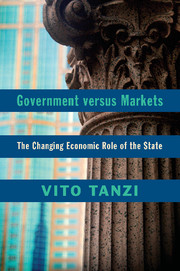Book contents
- Frontmatter
- Contents
- Preface
- PART ONE THE ECONOMIC ROLE OF THE STATE
- PART TWO HISTORICAL REVIEW
- 2 The Role of the State in the Pre–World War II Period
- 3 Forces That Changed the Role of the State
- 4 Growth of Public Spending and Taxation in the 20th Century
- 5 The Role of the State in Social Protection
- 6 Globalization and Public Spending
- PART THREE THEORETICAL AND ANALYTICAL ISSUES
- PART FOUR THE OUTCOME OF STATE INTERVENTION
- PART FIVE ON THE ECONOMIC ROLE OF THE STATE IN THE FUTURE
- Notes
- Index
- References
4 - Growth of Public Spending and Taxation in the 20th Century
Published online by Cambridge University Press: 07 October 2011
- Frontmatter
- Contents
- Preface
- PART ONE THE ECONOMIC ROLE OF THE STATE
- PART TWO HISTORICAL REVIEW
- 2 The Role of the State in the Pre–World War II Period
- 3 Forces That Changed the Role of the State
- 4 Growth of Public Spending and Taxation in the 20th Century
- 5 The Role of the State in Social Protection
- 6 Globalization and Public Spending
- PART THREE THEORETICAL AND ANALYTICAL ISSUES
- PART FOUR THE OUTCOME OF STATE INTERVENTION
- PART FIVE ON THE ECONOMIC ROLE OF THE STATE IN THE FUTURE
- Notes
- Index
- References
Summary
From World War I to the 1960s
In the now rich countries of the Western world, the levels of taxation and of public spending generally increased after World War II, though until 1960 the increase was relatively slow. During World War II, there had been large tax increases in several countries to finance the war. Except for the war years, the tax to GDP ratios remained below or around 30 percent of GDP in most industrial countries until the early 1960s. It increased sharply after 1960. The important exception in the tax increase was the United States. For several countries, 1960 can be considered the tipping point for the coming of mature “welfare states,” or for “mixed economies.”
There had been significant increases in the levels of taxation during World War I (to finance part of the huge spending for the war), followed by slow growth until World War II when, as had happened in the First World War, but in larger amounts, taxes were increased to finance the new war. Tax levels for general governments were only 11 percent of GNP in 1925–29 in the United States; 20 percent in France in 1924–25; and less than 10 percent until 1930 and still below 20 percent up to 1950 in Sweden. They were about 25 percent of GNP in 1924–25 and around 30 percent of GNP in the early 1960s in the United Kingdom.
- Type
- Chapter
- Information
- Government versus MarketsThe Changing Economic Role of the State, pp. 92 - 106Publisher: Cambridge University PressPrint publication year: 2011



